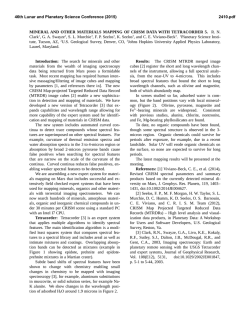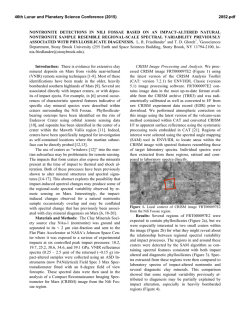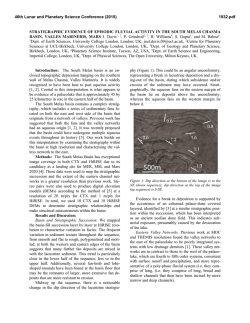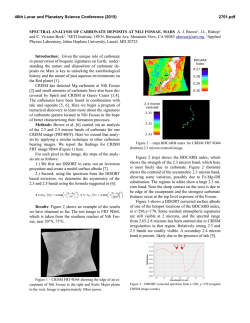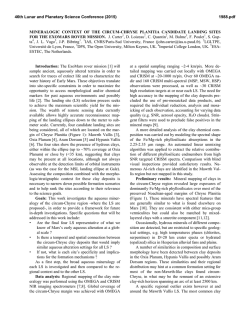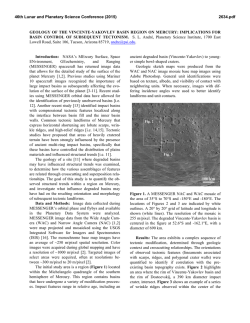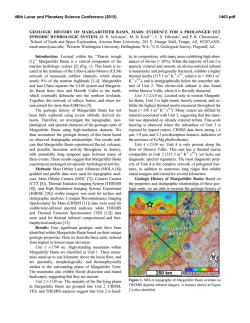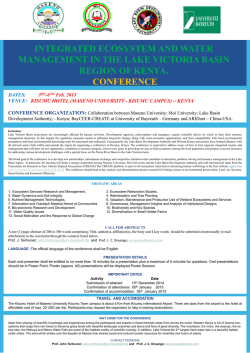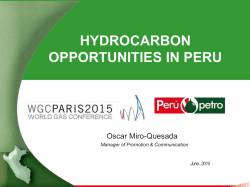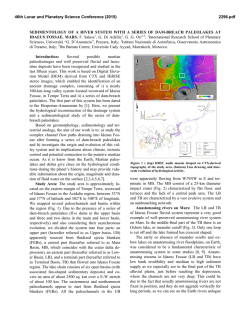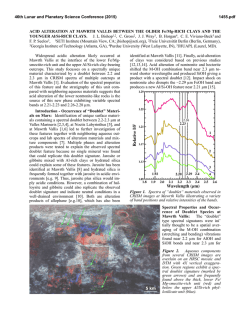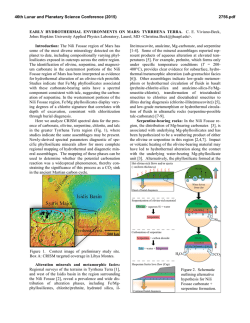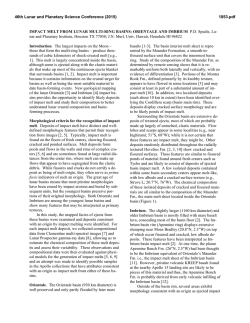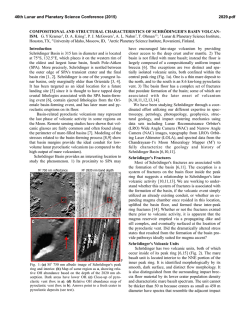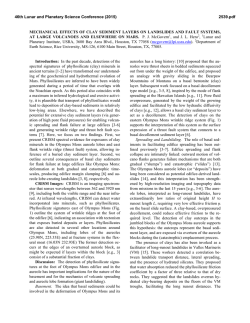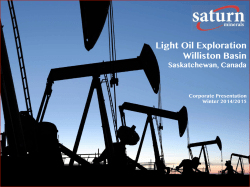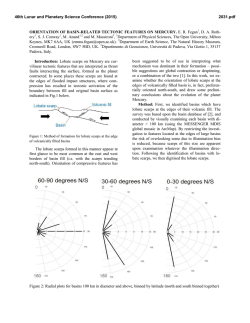
Mg-Rich Clays and Silica-Bearing Deposits in Eridania Basin
46th Lunar and Planetary Science Conference (2015) 2754.pdf MG-RICH CLAYS AND SILICA-BEARING DEPOSITS IN ERIDANIA BASIN: POSSIBLE EVIDENCE FOR ANCIENT SEA DEPOSITS ON MARS. J. R. Michalski1,2, E. Z. Noe Dobrea1,3, and C. M. Weitz1. 1 Planetary Science Institute, Tucson, AZ. 2 Natural History Museum, London, UK. 3NASA AMES Research Center, Moffet, CA. Introduction: The Eridania Basin is composed of a suite of ancient, modified, topographically connected impact basins located near 180° E, 30° S. There is strong geomorphic evidence that the basin likely contained a large (~3 x 106 km2) lake or sea [1]. The Ma’adim Vallis channel originates at what is interepreted as a spillway over the north boundary of the basin [1]. Valley networks [2] draining into the basin within the ancient terrain surrounding the basin generally terminate at an elevation near 1100 m [1] (Figure 1), suggesting that an acient sea level was present over an extensive period of time near this topographic level. If the surface of the Eridania sea was indeed located near the 1100 m-contour, it implies that the basin would have contained a sea ~1 km-deep. Previous researchers have identified several important geologic units associated with the basin. Of these, the most ancient appears to be the colles units, which occur near the deepest parts of the basin and are in some cases, seemingly embayed by younger ridged plains (interpreted as lavas) [2]. The third unit includes the “Electris Deposits” [3-4], which are composed of apparently fine-grained lithified airfall deposits (ash or dust) that have been moderately eroded and chemically altered in places. The focus of this work is the most ancient material: the colles deposits, which formed >3.5 Ga, possibly in a subaqueous setting [2]. We have analyzed the mineralogy of these deposits using CRISM infrared data and the geologic context of terrains using HiRISE and CTX images. In addition, we have searched for evidence of older units that might underlie the chaos materials by analyzing materials exhumed by impact craters that occur within the chaos and plains units. Methods: CRISM L-channel data (λ = 1-3.9 µm) were analyzed using the standard data pipeline, which corrects for instrument effects, calibrates the data to I/F, and performs a first-order atmospheric correction using the volcano-scan method [5]. All spectral analyses were performed on unprojected data to avoid uncertainties due to resampling. Both I/F and ratio spectra were used; spectral ratios were performed along the same or similar columns where possible. In many cases, however, we simply averaged hundreds of pixels from geological regions of interest (ROIs) and ratioed those data against spectrally unremarkable surfaces of similar albedo (where possible) in the same scene. HiRISE and CTX images were imported into a GIS environment to evaluate the geologic context of minerals detected with CRISM data. Results: The colles units exhibit reflectances ranging from light to intermediate in tone, and spectral signatures ranging from spectrally unremarkable to clear absorption features consistent with aqueous alteration. Observations of the colles units generally do not show spectral evidence for primary igneous mineralogy, in contrast to the overlying ridged plains materials which contain some very strong evidence for olivine. Specifically, the chaos materials exhibit spectral absorptions at ~1.4 µm, ~1.9 µm, and at 2.31-2.32 µm. These absorptions, and the overall spectral shape in the ratioed spectra, suggest the presence of Mg-rich clay minerals, specficially saponite, and possibly including talc-saponite mixed-layer clays, which are common in seafloor sediments [6] (Figure 2). In fact, the presence of a strong doublet at ~2.29 and ~2.31 µm is observed in talc-rich samples, as well as in some of our CRISM data. With increasing Fe-content, talc is more indistinguishable from saponite, with a less pronounced doublet and primary absorption feature located from 2.315-2.32 µm. Minor occurrences of opaline silica are observed in some of the clay-bearing spectra based on a subtle spectral feature at 2.23-2.24 (SiOH combination bands). However, in one case, an extremely strong signature of hydrated amorphous silica was detected image FRT000CAF3). This occurs in the rim of an impact crater into Colles terrain. This geologic setting is unusual, however, as the impact crater occurs within an infilled, older impact crater. Therefore, the silica might have been exhumed from the more ancient impact structure and likely could represent hydrothermal materials associated with that previous event. Summary: Our results so far suggest that alteration minerals are relatively common in the ancient colles units, and older units exhumed by impact craters in the Eridania Basin. Clay minerals are Mg-rich, and likely include saponite and potentially talc/saponite mixedlayer clays [6]. Opaline silica is also observed. These results are important because they support the previous suggestion based on detailed geomorphological analyses that these units formed subaqueously in a large basin. These deposits might represent deep-water sediments and subaqueous hydrothermal deposits that formed in an ancient Martian sea. 46th Lunar and Planetary Science Conference (2015) 2754.pdf References: [1] Irwin, R.P. et al (2004). J. Geophys. Res., 109, E12009. [2] Baker, D. M. and J. W. Head (2014), 44th LPSC, abstract #1252. [3] Grant, J. A. et al. (2010). Icarus 205, 53-63.[4] Grant, J. A. and P. H. Schultz (1990). Icarus 84, 166-195.. [5] Murchie, S. L. et al. (2009). JGR Planets, 114, E00D06. [6] Cuadros, J. et al. (2013). Chem. Geol. 360-361, 142158. [7] Hynek, B. M. et al. (2010), JGR Planets, 115, E003548 Ma’adim Vallis colles volcanic resurfacing colles Eridania Basin colles volcanic resurfacing Figure 1: The Eridania basin is bounded by the 1100 m-contour line, with colors indicating topography above this elevation. Many valley networks [7] (white lines) terminate at this level [1], which might indicate that an ancient baselevel occurred at this elevation. It is also the elevation of the Ma’adim Vallis spillway [1]. CRISM 4585 CRISM 8d2d CRISM 12fd9 CRISM caf3 100 m saponite talc/saponite talc/saponite MgOH amorphous silica 12fd9 SiOH 1.0 1.5 2.0 wavelength ( m) 2.5 Figure 2: (left) CRISM ratioed spectra compared with selected laboratory data . (lower right) A false color CRISM image containing talc (12fd9). (upper right) HiRISE blowup image of the talc-bearing deposits. The deposit contains ridges and fractures that might indicate mineralized zones (veins).
© Copyright 2026
